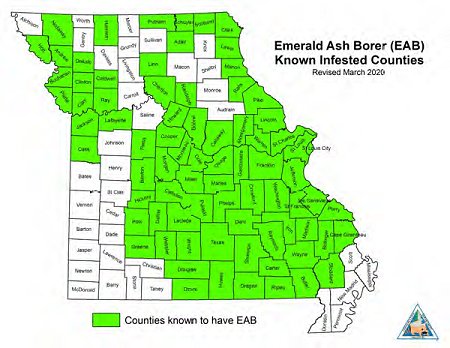AgEBB-MU CAFNR Extension
Green Horizons
Volume 24, Number 2
Spring 2020
Want to save your ash tree from EAB?
Robbie Doerhoff, MDC Forest Entomologist
Emerald ash borer (EAB) is becoming more widespread in Missouri with 78 counties known to have this tree-killing pest. If you have a live ash tree in your yard and you'd like to see it stay that way, now is the time to treat it with an insecticide. What insecticide should you use? That's a great question! Not all products will protect your tree from EAB, so it's important to understand your options when it comes to this pest. Check out MDC's EAB Management Guide for Missouri Homeowners for a list of insecticides recommended by EAB experts.
 |
Above: Updated map of EAB infestations in Missouri.This pest has been spreading to more counties since first recorded in the state. |
In addition to brushing up on insecticides, follow these steps when considering ash treatments:
- Make sure your tree is an ash! Learn to identify ash trees in this MDC video: https://www.youtube.com/watch?v=D_ZnTisLnwE
- Check the health of your tree. Look for dead branches, sprouts growing from the trunk, and woodpecker damage. If more than 50% of the tree's canopy is dead, it likely can't be saved.
- Measure your tree at chest height. If the diameter is 20 inches or less, you can treat the tree yourself using a soil drench insecticide purchased online or at your local garden center. If the tree is larger than 20 inches in diameter (63 inches in circumference), it needs to be treated by a professional arborist.
Visit www.treesaregood.org for a list of certified arborists in your area. - It's time to treat! The best time for homeowners to apply EAB treatments is during the spring as ash trees are leafing out. Waiting until later in the growing season can lead to slower uptake by the tree and less protection from EAB.
When using insecticides, make sure you read the label thoroughly and apply the product according to the directions. Most soil drench products for EAB are intended as a single, annual application in the spring; applying the product more than once a year can put pollinators and other non-target insects at risk of exposure. Avoid applying soil drench products within the root zone of flowering plants, when soils are waterlogged, or right before a large rain event.
Unfortunately, ash trees in forests across Missouri will soon be dead as EAB continues its march across the state. Landowners often notice woodpecker damage on their ash during the winter months. This is typically the first sign of EAB in an area and is an indication that most of the ash will be dead within a couple years. EAB-killed ash trees are very brittle and dangerous, so be extremely cautious when cutting firewood or working near them. Young ash trees (under 10 inches in diameter) are likely to escape the initial wave of EAB attack and may need to be managed, depending on the landowner's forest management goals.
For questions related to EAB, ash tree treatments, or managing ash in forests, send an email to forest.health@mdc.mo.gov or call MDC's Forest Entomologist, Robbie Doerhoff, at (573)815-7901, extension 2906.
For MDC's EAB Management Guide for Missouri Homeowners, visit short.mdc.mo.gov/ZSq.
